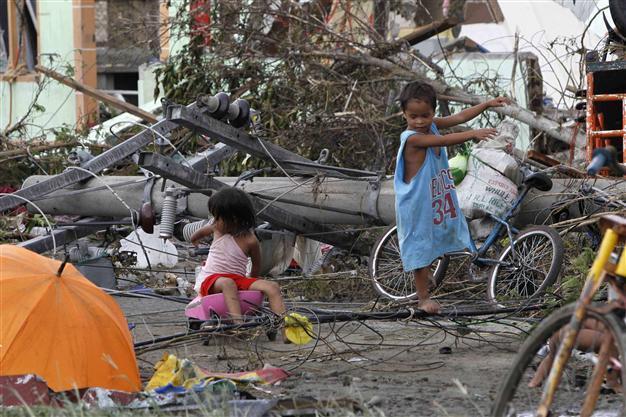Over 1,200 feared dead in typhoon-devastated Philippines
TACLOBAN - Agence France-Presse

hildren play near electric posts which were damaged after super Typhoon Haiyan battered Tacloban city, central Philippines, Nov. 9. REUTERS photo
One of the most powerful typhoons in history is believed to have killed 1,200 people in the Philippines, the Red Cross said Nov. 9, as rescue workers raced to reach towns devastated by tsunami-like waves.A day after Super Typhoon Haiyan whipped across the central Philippines with maximum sustained winds of around 315 kilometres an hour, a picture emerged of entire communities having been flattened.
Authorities said that, aside from the ferocious winds, storm surges of up to three metres high that swept into coastal towns and deep inland were responsible for destroying countless homes.
"Imagine a strip one kilometre deep inland from the shore, and all the shanties, everything, destroyed," Interior Secretary Mar Roxas said after visiting coastal towns in Leyte, one of the worst-hit provinces in the east of the archipelago.
"They were just like matchsticks flung inland. All the houses were destroyed." The official government death toll on Nov. 9 night was 138.
But with rescue workers yet to reach or communicate with many ravaged communities across a 600-kilometre stretch of islands, authorities said they were unable to give a proper assessment of how many people had been killed.
Philippine Red Cross secretary general Gwendolyn Pang said her organisation estimated 1,200 people had died, while a U.N. official who visited Leyte described apocalyptic scenes.
"This is destruction on a massive scale. There are cars thrown like tumbleweed and the streets are strewn with debris," said Sebastian Rhodes Stampa, the head of a U.N. disaster assessment coordination team.
"The last time I saw something of this scale was in the aftermath of the Indian Ocean tsunami," he said, referring to the 2004 disaster that claimed about 220,000 lives.
Stampa made his comments after arriving in Tacloban, the destroyed capital of Leyte with a population of about 220,000 people.
More than 100 bodies were littered in and around Tacloban's airport, according to the facility's manager.
AFP journalists who arrived in Tacloban on a military aircraft encountered dazed survivors wandering amid the carnage asking for water, while others sorted through what was left of their destroyed homes.
More than 800,000 evacuated
Energy Secretary Jericho Petilla reached the fishing town of Palo, about 10 kilometres from Tacloban, by helicopter and said he believed "hundreds" of people had died just in that area.
Pope Francis tweeted his support for the typhoon victims: "I ask all of you to join me in prayer for the victims of Typhoon Haiyan/Yolanda especially those in the beloved islands of the Philippines." Race to reach decimated communities Meanwhile, the military, government relief workers and non-government organisations battled to reach communities and deliver desperately needed supplies.
Fifteen thousand soldiers were in the disaster zones and helping in the rescue effort, military spokesman Lieutenant-Colonel Ramon Zagala told AFP.
Zagala said helicopters were flying rescuers into priority areas, while infantry units deployed across the affected areas were also proceeding on foot or in military trucks.
Haiyan's wind strength, which remained close to 300 kilometres an hour throughout Nov. 8, made it the strongest typhoon in the world this year and one of the most intense ever recorded.
It exited into the South China Sea on Saturday and tracked towards Vietnam, where more than 200,000 people crammed into storm shelters. Philippine authorities had expressed confidence on Friday that only a few people had been killed, citing two days of intense preparation efforts led by President Benigno Aquino.
Nearly 800,000 people in danger zones had been moved to evacuation centres, while thousands of boats across the archipelago were ordered to remain secured at ports. Hundreds of flights were also cancelled.
Aquino said on Nov. 8 night it appeared some communities had not heeded the warnings.
"I hesitate to say this, but it seems that Tacloban was not that prepared, shall we say, compared with other areas," he told reporters in Manila.
An average of 20 major storms or typhoons, many of them deadly, batter the Philippines each year as they emerge from the Pacific Ocean.
The Philippines suffered the world's strongest storm of 2012, when Typhoon Bopha left about 2,000 people dead or missing on the southern island of Mindanao.
Haiyan is expected to make landfall in central Vietnam early Sunday, with millions of people thought to be in its path.
Authorities have begun mass evacuations in at least four central coastal provinces, Vietnam's state-run VNExpress news site said, as the country was put on high alert.
















